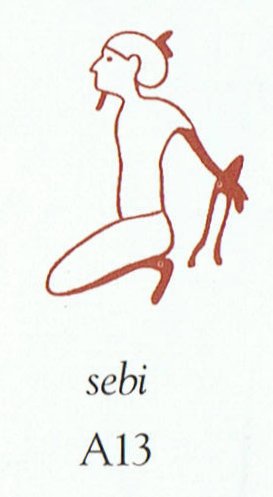4. Leaving these speculations aside we can look at the Babylonian zodiac, where we can see a Dead Man carried up into the sky by an Eagle:  The figure of the Dead Man is drawn like they used to picture prisoners in ancient Egypt, with arms bound at the back, here as described in Wilkinson:
A13 refers to Sir Alan Gardiner's well-known Sign List, according to which a prisoner very well could be regarded as an adversary (traitor) of the Pharaoh:
Bound hands should be on the back side, I think, because a pair of hands can represent the 10 months of Sun. By being on the back side they are pacified, changed from an active to the passive state. The Eagle is highly alive and not a Falling Eagle. The flight takes the 'prisoner' up, following the Milky Way. Hamlet's Mill has cryptic comments which surely must be considered: "There is also a Finnish folktale which repeats the well-known Babylonian story of Etana and the Eagle.² ² See M. Haavio, Der Etanamythos in Finnland (1995), pp. 8-12; also S. Langdon, The Legend of Etana and the Eagle (1932), pp. 46-50. Here, instead of the King, it is the 'Son of the Widow' (no reason is given for this epithet, which appears to belong to Perceval in the first line, but we find it again in later Masonic tradition)³ who is taken up into the air by a griffin and sees the earth growing smaller and smaller under him. ³ Such words have long lives. At the height of Pickett's Charge at Gettysburg, the first man over the wall was Gen. Armistead, who fell into the breach mortally wounded. To those who picked him up, the general kept repeating: 'I am a Son of the Widow' - obviously the password of a secret military brotherhood that his captors did not understand, nor the historian eíther. When the earth appears 'no bigger than a pea' (analogous similes are to be found also in Etana), the griffin plunges straightaway to the bottom of the sea, where the hero finds a certain object for which he had looked everywhere, and finally he is restored to land. This looks like the full story of what in the Babylonian cuneiform is interrupted halfway through because the tablet is broken off: it might be the first version of the legend of Alexander exploring the Three Realms." The text immediately previous was as follows (cfr at The Little Bald Woman): ... Youkahainen tries to overcome the ancient sage by asking cosmological riddles, but Vainamoinen 'sings' the Lapp step by step into the bog up to his throat, and sings his magic formulae 'backwards' to free him only when the Lapp has promised him Aino, his only sister. There was also the tale of Vainamoinen searching in the dead giant's belly for three lost runes. These, unless they are treated as 'just so stories', look very much like 'erratic boulders' deposited in Finland by the glacial movement of time. For once, it is possible to trace the archaic formation back to Egypt. A young Egyptian called Setna (or Seton Chamwese) wanted to steal the magic book of Thot from the corpse of Nefer-ka Ptah, one of the great Egyptian gods, who was often portrayed as a mummy. Ptah, however, was awake and asked him: 'Are you able to take this book away with the help of a knowing scribe, or do you want to overcome me at checkerboards? Will you play Fifty-Two?' Setna agreed, and the board with its 'dogs' (pieces) being brought up, Nefer-ka Ptah won a game, spoke a formula, laid the checkerboard upon Setna's head and made him sink into the ground up to his hips. On the third time, he made him sink up to his ears, then Setna cried aloud for his brother, who saved him ... According to Wilkinson - commenting on A13 in his Hieroglyfernas värld (Reading Egyptian Art) - small bound figures were sometimes used as pieces in the senet (and similar) board games.
Flipping a coin illustrates how fate rules, either it will be heads or it will be tails. Either you will win or will be defeated. Gambling stick are similar. The origin of the word sinnet (or sennet) seems to be without explanation (according to The Oxford Dictionary of English Etymology). My own view is that words never have any origin possible to follow to its ultimate source. However, there might be a connection with the board game senet. Presumably pawns needed only a simple bond for their pair of hands, but we know a 5-fold bond was necessary for Hercules. And an even stronger bond may have been needed for the Polynesian war god 'Oro:
"The war god Oro ... was worshipped all over Polynesia, but in Tahiti not represented by a carved human figure. Instead he was a bundle tied up with cords over a wooden core; limbs and facial features can, however, be recognized. Pleated sinnet on wood, Tahiti." (New Larousse Encyclopedia of Mythology) |



